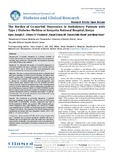| dc.description.abstract | Background: Co-morbid depression is a serious condition in
patients with diabetes that negatively affects their self-management,
including drug adherence, consequently, the treatment outcomes
and quality of life are also affected.
Objective: To determine the burden of co-morbid depression in
ambulatory patients with type 2 diabetes at the Kenyatta National
Hospital (KNH) and to document their socio-demographic and
clinical characteristics and any associated risk factors.
Methods: This was a cross-sectional study done on patients living
with type-2 diabetes on follow-up at the diabetes out-patient clinic
(DOPC) at the KNH. Systematic sampling method was used to
recruit 220 study subjects. The PHQ-9 questionnaire was used
to assess for co-morbid depression. Socio-demographic and
clinical details were obtained both from the subjects and their
medical records. Physical examination was done, including blood
pressure and BMI determined. Blood samples were collected from
the cubital fossa to measure HbA1C in COBAS INTEGRA system
with its reagent in the pre-dilution cuvette for automated analysis of
glycated hemoglobin (HbA1c). Statistical associations of patients’
characteristics and co-morbid depression were determined using
Chi-square test and Odds Ratios.
Results: The prevalence of co-morbid depression in patients
with type 2 diabetes at the DOPC of KNH using the PHQ-9 was
32.3% (95% CI 26.4-38.6%). Of these, depression was mild in
42.3%,moderate in 40.8% and severe in 16%. Subjects with comorbid
depression were: aged 65years and above (p = 0.006),
over-weight/obese (p = 0.035), and had longer duration of diabetes
of 5years and above. The presence of co-morbid depression was
significantly associated with poor glycaemic control, (OR = 3.3,
95% CI, 1.6 - 6.8, p = 0.001).
Conclusion: About one-third (32.3%) of the study subjects with
type 2 diabetes had co-morbid depression. Patients with type 2
diabetes who are at higher risk (older age of 65 years and above,
long duration of diabetes, poor glycaemic control and presence of
diabetes-related complications,) should be screened for co-morbid
depression. | en_US |



